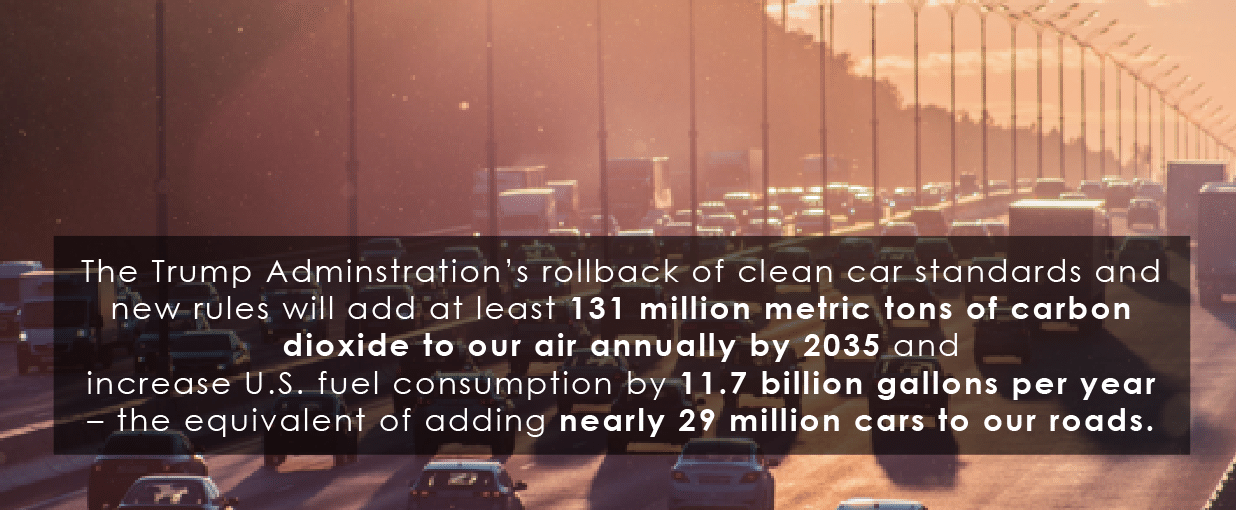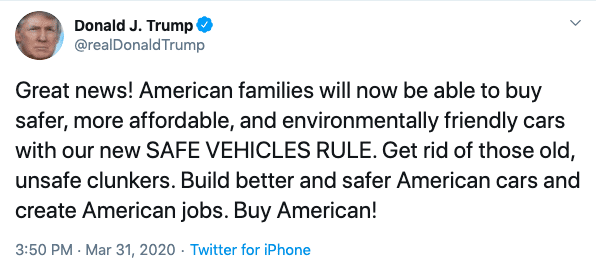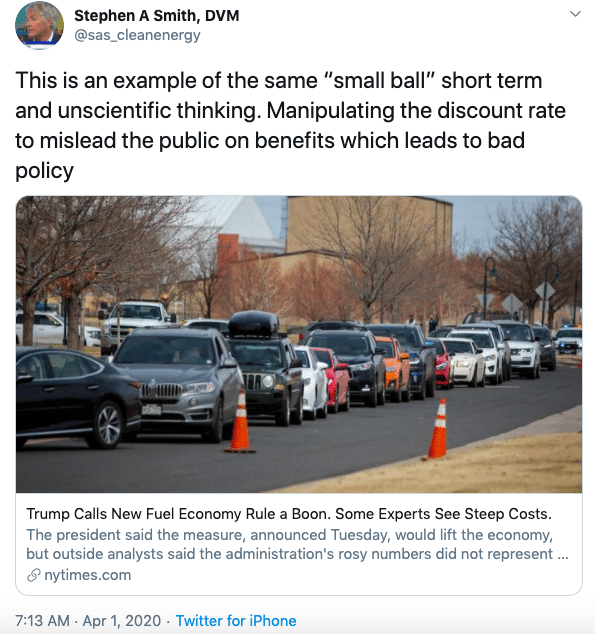This blog was co-written by Jennifer Rennicks, former Senior Director of Policy & Communications at the Southern Alliance for Clean Energy, and was updated on April 14, 2020 with additional material.
Stan Cross and Guest Blog | April 7, 2020 | Clean Transportation, Energy Policy
You may have seen in the news last week that amid a global pandemic, the Trump Administration rolled back clean car standards: national regulations and incentives designed to save consumers money, reduce transportation pollution, and spur climate-friendly automotive innovation.
The newly-finalized, short-sighted rule requires cars and light trucks to improve vehicle efficiency by only 1.5% per year between the model years 2021 and 2026 versus nearly 5% annual efficiency improvements established under the initial Clean Car Standard in 2012.
The Trump Administration’s Flawed Analysis
The core issue is the flawed science and economics behind the Trump administration’s rationale for the rule changes. The Clean Car Standards, enacted by the Obama Administration in 2012, were designed to raise the corporate average fuel economy to 54.5 MPG by 2025. The standards were developed through rigorous analysis led by the Environmental Protection Agency (EPA), in order to cut auto greenhouse gas emissions in half, reduce oil consumption by 2 billion barrels per day, and save American consumers $1.7 trillion in fuel costs.
Shortly after Trump took office, he tasked the National Highway Transportation Safety Administration to redo the research and issue a new report on the costs and benefits of the clean car standards. The NHTSA blocked EPA participation, not allowing EPA to perform even its most basic functions like engine testing.
Alarmingly, when the NHTSA’s shared their calculations with the EPA, experts began warning these rollbacks would be an economic, environmental, and public health disaster. As highlighted in the New York Times, the Trump Administration manipulated data, particularly the economic calculation knows as the “discount rate,” in order to justify the public policy change they sought:
As an example, other experts pointed to the fact that, in the administration’s own analysis, the overall economic impact of rolling back the auto rule could range from a net cost to the economy of $22 billion to a net benefit of $6.4 billion.
That wide range comes from using two different variables in an economic calculation known as the discount rate. Using a 3 percent discount rate, which would place a high value on lost benefits like improved public health from cleaner air, the new Trump plan would cost the economy $22 billion. Under a 7 percent discount rate, which would place a low value on those benefits, the rule would create a net economic benefit of $6.4 billion.
Analysts said those calculations demonstrated that the rule was likely to be more costly to society.
“It is highly unusual to emphasize the 7 percent discount rate — typically we always did calculations with the 3 percent discount rate,” said Margo Oge, a former top official in the E.P.A.’s vehicle emissions program. “That is more representative of the way the federal government does these calculations.”
Last week SACE’s Executive Director, Dr. Stephen Smith, called foul on manipulating data and the public trust in order to create public policy:


Another expert that warned of the negative impacts of these rollbacks was Jeff Alson, an engineer with 40 years of experience at the EPA’s Office of Transportation and Air Quality, who authored this in an oped in The Hill:
“The technical analyses behind both the 2018 proposed rule and the final rule were prepared by the National Highway Traffic Safety Administration (NHTSA), which has little fuel economy or auto emissions expertise. It does not have a vehicle test laboratory and has never performed a vehicle fuel economy or emissions test. The 2018 NHTSA analysis was biased and misleading. NHTSA completely cooked the books to get the answers that the White House wanted. The documents were ridiculed by EPA staff (whose world-class expertise was totally ignored by NHTSA and EPA’s political leadership), safety experts, academic economists, environmental and consumer groups, and even some automakers,” opined Alson.
And it’s not just government experts that are calling foul. In 2018, a group of 11 scientists published a critique of the NHTSA’s fuel standards analysis in the journal Science which found that the “analysis has fundamental flaws and inconsistencies, is at odds with basic economic theory and empirical studies, is misleading, and does not improve estimates of costs and benefits of fuel economy standards beyond those in the initial analysis.”
Consumer Impact
Higher fuel efficiency standards translate into consumer savings at the pump. By hitting the brakes on fuel standards, ACEEE estimates the administration’s new rule will cause the owner of an average model year 2025 vehicle to fill up the gas tank 62 more times over the life of the vehicle.
NRDC points out that the Trump administration’s own analysis estimates that Americans will consume an added 78 billion gallons of fuel due to these newly finalized standards, draining billions of dollars from consumers’ wallets.
The bottom line: fuel efficiency standards save consumers money, and rolling back those standards hurts consumers.
Autoworker Impact
According to an article published in The Atlantic, the Trump administration’s own analysis concluded that the rollback will eliminate 13,500 autoworker jobs. The nearly 2,000-page rollback is free to read online. On page 1,409, it is stated that the changes will “slightly reduce estimated U.S. auto sector labor hours.” But a table on page 1,721 shows that the policy will actually lead to 13,474 fewer jobs compared with the existing Obama-era standards.
Between March 15 and April 4, nearly 17,000,000 Americans filed for unemployment including 6.6 million in the first week of April alone. To put this level of unemployment claims into perspective, as of April 4, more than 1 in 10 American workers are seeking jobless benefits.
Given that many economists predict that the unemployment rate will top the Great Depression’s 25%, enacting a policy that expects to further cut jobs makes no sense.
Public Health Impact
While impacts on consumers’ wallets are not to be taken lightly, especially during an economic crisis, it is particularly egregious that this new policy would undermine public health at the height of a public health crisis.
Despite these baseless claims from the Trump Administration that these news standards would benefit consumers, even the government’s own analysis of the so-called Safer Affordable Fuel-Efficient Vehicles rule shows there will be adverse public health impacts from these weaker standards. For example, the Union of Concerned Scientists points to the Trump administration’s own analysis which suggests upwards of 1,444 premature deaths from air pollution could result from these new rules.
The additional air pollution resulting from these new rules will compound an existing air quality problem. According to the American Lung Association’s 2019 State of the Air report, 4 out of 10 Americans live in counties already experiencing unhealthy levels of pollution. The report also shows that, in many cities, air pollution worsened between 2014-2017.
While our nation confronts the challenges of a virus that attacks the respiratory system, and while 40% of citizens live in communities where unhealthy air makes it more difficult to breathe, the Trump administration is making America’s air dirtier and further compromising Americans’ health.
Climate Change Impact
At a time when most of the world’s leading economies are accelerating renewable energy and electric vehicle deployment to reduce greenhouse gas emissions and reverse alarming global warming trends, these new rules will solidify America’s position as a climate laggard.
ACEEE estimates the new rules will add at least 131 million metric tons of carbon dioxide to our air annually by 2035 and increase U.S. fuel consumption by 11.7 billion gallons per year – the equivalent of adding nearly 29 million cars to our roads.
Furthermore, the new rules pull against electric vehicle (EV) market momentum. The auto industry has committed to investing $300 billion to bring an increasing number of desirable electric models to market over the next 5-10 years. Accelerating EV deployment worldwide is a critical climate strategy given that transportation is the most significant emissions sector and that EVs reduce greenhouse gas emissions by upwards of 70%.
Weakening the clean car standards undermines America’s global clean technology leadership, sends the wrong message to an auto industry poised to electrify and worsens the climate crisis.
Time to Act
Like many of this administration’s previous rollbacks, the ironically-named SAFE vehicle rule will end up being challenged in the courts. Several states and environmental groups have pledged to sue the Trump administration seeking to halt the rule changes from taking place.
There’s still a chance to stop this rollback and we invite you to join the League of Conservation Voters in Tweeting to automakers to commit to maintaining the Clean Car Standards. We also invite you to stay informed about our efforts to educate and empower individuals, communities, municipalities, policymakers, and utilities to transition to clean, electric transportation throughout the Southeast. Visit Electrify the South.org to learn more or join our monthly clean transportation newsletter here.